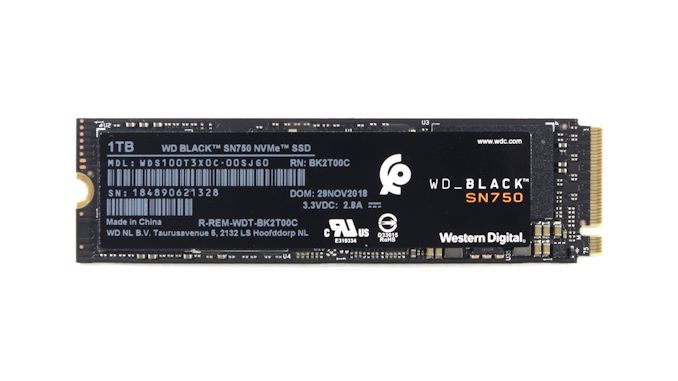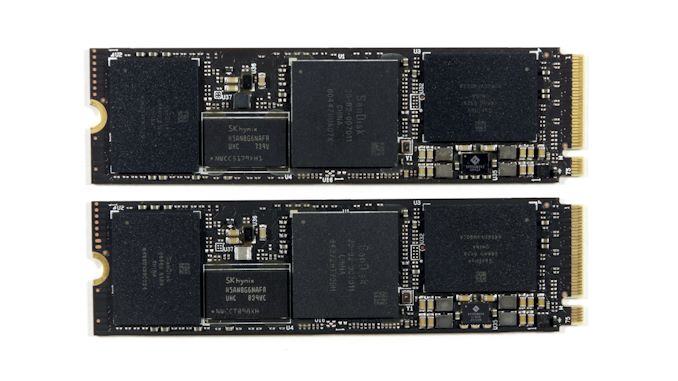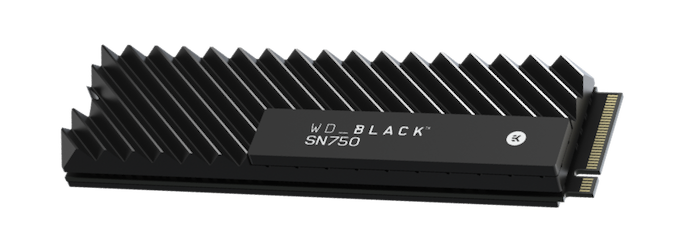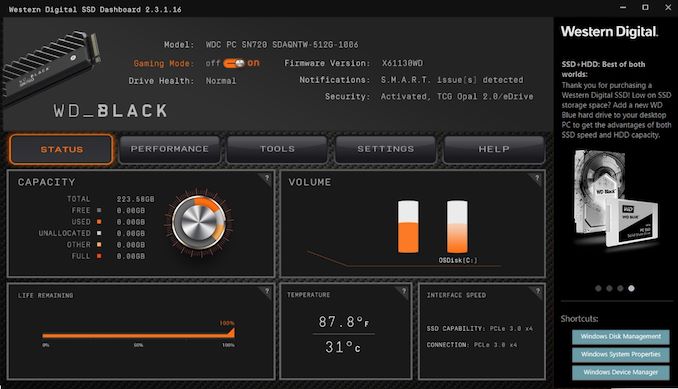The Western Digital WD Black SN750 SSD Review: Why Fix What Isn't Broken?
by Billy Tallis on January 18, 2019 8:01 AM EST
Last year Western Digital overhauled their WD Black NVMe SSD with an upgrade to 3D NAND and a new in-house SSD controller, transforming the product line from one of the slowest NVMe drives to one of the top high-end competitors. Now the third generation WD Black SSD is here, with the model number SN750 to avoid confusion with its predecessors. (Internally, last year's model was known as the SN700, and the OEM version was the SN720.) The new WD Black SN750 is an incremental update over last year's model, keeping the same basic controller and 64L 3D NAND combination but refining the firmware and adding a 2TB option. Western Digital is also shifting their marketing efforts more toward gamers with the addition of SKUs featuring a large heatsink.
The second-generation WD Black launched last year delivered performance that is generally competitive with other top NVMe SSDs like the Samsung 970 EVO, while usually operating with far better power efficiency. The only other high-end NVMe SSDs that have similar efficiency are the Toshiba XG5 and XG6, but the controller they use puts them clearly in a lower performance class than the WD Black. However, last year's model was still the first release of a new controller architecture, so it is no surprise that Western Digital has some firmware improvements to deliver. It is a bit disappointing that those improvements aren't being distributed as free firmware updates to owners of last year's model, but Western Digital is not the only company that's taken this approach.
| Western Digital WD Black SN750 Specifications | ||||||
| Capacity | 250 GB | 500 GB | 1 TB | 2 TB | ||
| Form Factor | M.2 2280 single-sided optional heatsink (except 250GB) |
|||||
| Interface | PCIe 3 x4 NVMe 1.3 | |||||
| Controller | Western Digital in-house | |||||
| NAND Flash | SanDisk 64-layer 3D TLC | |||||
| Sequential Read | 3100 MB/s | 3470 MB/s | 3470 MB/s | 3400 MB/s | ||
| Sequential Write | 1600 MB/s | 2600 MB/s | 3000 MB/s | 2900 MB/s | ||
| Random Read | 220k IOPS | 420k IOPS | 515k IOPS | 480k IOPS | ||
| Random Write | 180k IOPS | 380k IOPS | 560k IOPS | 550k IOPS | ||
| Power | Peak | 9.24 W | 9.24 W | 9.24 W | 9.24 W | |
| PS3 Idle | 70 mW | 70 mW | 100 mW | 100 mW | ||
| PS4 Idle | 2.5 mW | 2.5 mW | 2.5 mW | 2.5 mW | ||
| Warranty | 5 years | |||||
| Write Endurance | 200 TB 0.4 DWPD |
300 TB 0.3 DWPD |
600 TB 0.3 DWPD |
1200 TB 0.3 DWPD |
||
| MSRP (No heatsink) |
$79.99 | $129.99 | $249.99 | $499.99 | ||
Aside from the addition of the 2TB option, the most noticeable changes to the specs table are the vastly lower MSRPs: the 2TB will debut for only $50 more than the 1TB model was at introduction last year, and the smallest price drop is the 33% cut to the 250GB model's price tag.
Performance has been improved slightly across most of the major metrics, but none of the improvements are anything huge. The 2TB model will actually be slightly slower than the 1TB, due in part to using 512Gb NAND dies instead of 256Gb dies so that the 2TB model can still be a single-sided M.2 card.
The 2TB model and the SKUs equipped with heatsinks will be arriving this spring, but the plain 250GB through 1TB models ship this month. Western Digital has not provided MSRPs for the models with heatsinks, but we expect them to carry a bit of a premium when they arrive.
Peeking under the label, we find essentially the same PCB as last year's model, though it appears we've gone from revision A to revision D. The WD Black SN750 is equipped with the same controller and NAND parts as last year's WD Black and SanDisk Extreme Pro, and the only differences in chip markings appear to be date codes or lot numbers.

Top: 2nd Gen WD Black (SN700)
Bottom: 3rd Gen WD Black SN750
Unlike last year's model, the new WD Black SN750 does not have a sibling product under the SanDisk brand; the SanDisk Extreme Pro NVMe SSD is now strictly speaking an outdated product, though it is still very similar to the new WD Black.
Western Digital has made a few superficial changes to the WD Black to make it more gamer-oriented. The product packaging and labeling has been restyled, and all but the smallest model will soon be available in versions with a custom aluminum heatsink from EKWB. Additionally, there's a new version of Western Digital's new SSD Dashboard software for Windows that adds a "Gaming Mode" which re-configures the NVMe driver to not enable Autonomous Power State Transitions. When this gaming mode is enabled, the drive won't make use of its low-power idle states, which avoids the extra latency of waking the drive up after it has been idle for a few seconds. However, in our experience few gaming desktops are configured to use the deepest idle states, and the WD Black wakes up very quickly from its intermediate idle, so this feature will be inconsequential for most users.
Our Linux-based synthetic performance tests are already conducted with APST off so that idle wake-up latency doesn't distort those results. Our Windows-based ATSB trace tests leave APST enabled, but the trace playback cuts idle times short enough that most NVMe drives won't be entering low-power states during those tests, either. The SYSmark 2018 test gives SSDs plenty of idle time to make use of their deepest idle states, but overall the workload it presents is not storage-intensive enough for WD's Gaming Mode to have a noticeable effect.
It may seem odd that Western Digital is sticking with their 64-layer 3D NAND even months after their partner Toshiba started shipping 96L 3D NAND with the XG6, but the transition to 96L NAND will look very different from the transition to 64L NAND. The 64L generation leveled the playing field as Toshiba and Western Digital delivered their first 3D NAND worth mass producing, and Intel and Micron made significant performance improvements over their previous 32L NAND. As most of the major manufacturers largely caught up to Samsung and ramped up production, prices crashed. That's been great news for consumers, but has prompted the manufacturers to slow their investments into 96L production to avoid worsening the oversupply. Thus, we expect the 96L transition to proceed more slowly, taking all of 2019 and probably into 2020 before every 64L product line gets upgraded. The 96L upgrade has the potential to bring some significant performance and power improvements, but will in most cases require a new generation of controllers that can take advantage of higher controller-to-NAND interface speeds or lower operating voltages.
Since last year's WD Black launched, the most important new competitors to hit the scene have been drives based on Intel/Micron NAND with the SM2262 controller, and drives using the same Toshiba/SanDisk NAND with the Phison E12 controller. The SM2262 drives (represented in this review by the HP EX920) are now being phased out in favor of the upgraded SM2262EN controller, which we previewed last year. Representing the Phison E12 family, we have the Corsair Force MP510 960GB.
| AnandTech 2018 Consumer SSD Testbed | |
| CPU | Intel Xeon E3 1240 v5 |
| Motherboard | ASRock Fatal1ty E3V5 Performance Gaming/OC |
| Chipset | Intel C232 |
| Memory | 4x 8GB G.SKILL Ripjaws DDR4-2400 CL15 |
| Graphics | AMD Radeon HD 5450, 1920x1200@60Hz |
| Software | Windows 10 x64, version 1709 |
| Linux kernel version 4.14, fio version 3.6 | |
| Spectre/Meltdown microcode and OS patches current as of May 2018 | |
- Thanks to Intel for the Xeon E3 1240 v5 CPU
- Thanks to ASRock for the E3V5 Performance Gaming/OC
- Thanks to G.SKILL for the Ripjaws DDR4-2400 RAM
- Thanks to Corsair for the RM750 power supply, Carbide 200R case, and Hydro H60 CPU cooler
- Thanks to Quarch for the XLC Programmable Power Module and accessories
- Thanks to StarTech for providing a RK2236BKF 22U rack cabinet.
















54 Comments
View All Comments
namechamps - Friday, January 18, 2019 - link
Strangely enough I don't think anandtech has ever reviewed the 970 Pro which is likely why it isn't in the comparison. They have done the 960 pro and the 970 evo but not the 970 pro.Ryan Smith - Friday, January 18, 2019 - link
"Whatever happend to the Samsung PRO in those comparisons?"Unfortunately Samsung never sampled the 970 PRO, so we don't have it on hand. And all indications are that they're just about done with it, having never released a 2TB version (like they did the 960 PRO).
I'm really not sure if we're going to see any new consumer MLC drives in 2019. The market has bifurcated into TLC and then more boutique solutions like Z-NAND and 3D XPoint.
althaz - Friday, January 18, 2019 - link
The 512Gb drive is a ~$150 part, just buy it and test it? To many this remains the most prestigious tech site around for at least some things. SSDs have been one of those things. Not having the latest of Samsung's pro drive in your results kinda makes this whole thing not worth it, IMO.If you need an excuse do a "MLC Redux" review where you look at what was probably the faster ever MLC drive and talk about how SSD tech has changed.
eldakka - Friday, January 18, 2019 - link
" just buy it and test it?"I'm sure anandtech would be delighted to test it if you sample one to them, or donate $150 to them to purchase one with.
GreenReaper - Saturday, January 19, 2019 - link
This is the level of a business expense though. Even if you did one a day for every day of the year it would be $53,400. OK, you could get a full-time journalist for that in some places, but that assumes they are kept and not sold on or used for anything else.Solandri - Monday, January 21, 2019 - link
More troubling is that unwillingness to buy a product for review smacks of demanding bribes. "Give us a free sample or we won't review your product." Which implies that companies which shower the reviewer with gifts will get more favorable reviews.Ideally, a review site should *never* accept free samples, and do all their product reviews with samples bought from the store. That's the only way to completely eliminate any undue influence the product manufacturer may have on the product review.
Dark_wizzie - Friday, January 18, 2019 - link
I don't think they actually reviewed the 970 Pro?StevoLincolnite - Saturday, January 19, 2019 - link
Yeah. Comparisons have been a bit crap on Anandtech lately.The RTX 2080 review is lacking a good lineup of GPU's to compare with... Despite promises of "Adding more later". (Never happened sadly.)
joesiv - Friday, January 18, 2019 - link
I would love to see at least some endurance testing in anandtechs reviews. I think it's something that's missing pretty much all SSD testing I see. Yes, speed is great, but endurance is something perspective owners will care more about in the long term.NAND technology is changing over time, is it changing for the better? More layers, but often at the expense of P/E Cycles.
SSD Firmwares as well have gotten both a lot more reliable, but also a lot more complicated, with different companies doing different things to maximize performance and also endurance.
Without testing these things, we don't know if there are duds in terms of firmwares/drives that don't strike a good balance between performance/reliability.
Bare minimimum I would love to see ananadtech do the following:
- Talk to manufacturers about the actual specifications of the NAND, what is the P/E Cycle rating for the NAND. Then list it in the specs for the drives so we can do our own research/homework if we want to. This spec is very often missed in the most marketing material.
- Do a quick capture of the SMART data at the very start of the testing
- Do a capture of the SMART data at the very end of your testing.
- Check out the Block Erase Count specifically. The Average Block Erase count would give a good approximation of how much life you've used just within your benchmark suite. It's much more grainular than Percent Life Used. This SMART attribute can vary between different manufacturer/firmware/controllers, so you might need to contact the manufacturer for this info.
In the end, you'll have something like: Rated P/E count / Average Block Erase, and since your test suite is likely pretty similar between SSD's, it would be a useful metric.
Bonus points, you could also look at NAND writes (not to be confused with Host Writes), during your testing, as it's related to life expectancy and can be corrolated with Total Byte Written.
I wouldn't be surprised to see that some drives write a lot more to NAND than you are expecting, and thus have higher Average Block Erases during your testing.
At my company when I did this test, while we were evaluating a drive for our products, Tier 1 memory manufacturers and their drives, failed bitterly at this endurance test where most did fine. I attribute this to the firmware. Working with the firmware developement team, we determined that the fix would not be feasible in that generation of product, so we had to skip that product.
Specs aren't everything, we need to test it, endurance is an important aspect, and I'd love to see it represented in your reviews.
romrunning - Friday, January 18, 2019 - link
Whom do you consider to be "Tier 1 memory manufacturers" - Samsung or Intel? I can't imagine their products failing endurance tests. Or are you talking about those you would consider to be lower than Samsung - like AData, Team Group, etc. - as a Tier 2 or Tier 3?